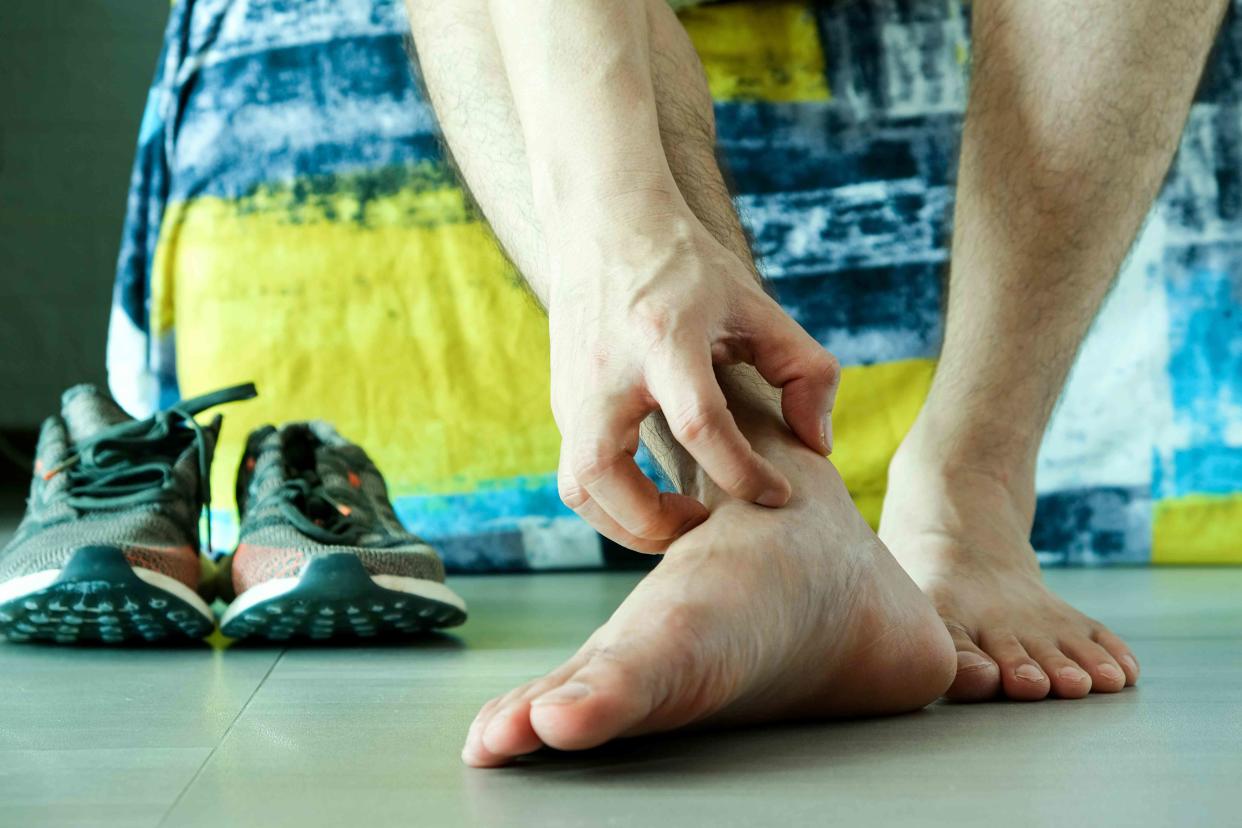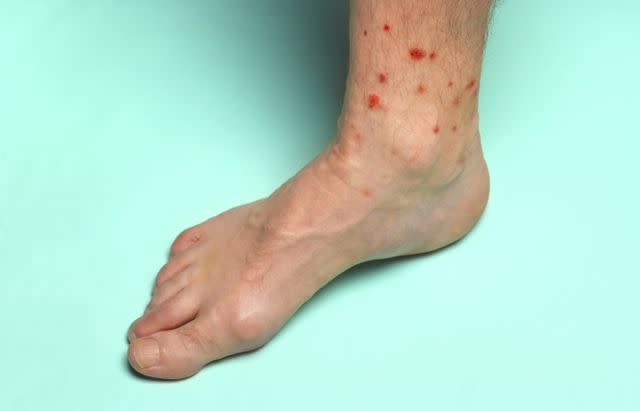What to Know About Chiggers and Their Bites

Ake Ngiamsanguan / Getty Image
Medically reviewed by William Truswell, MD
Walking in tall grass or weeds, you might cross paths with a chigger and be subject to it's itch-inducing bites. Chiggers are larvae—the active, immature form—of mites. Chiggers feed on a variety of sources, including reptiles, birds, rodents, and sometimes humans. The bites are most common in the summer and fall and typically appear on your ankles and waist. Usually, chigger bites and their symptoms go away with at-home treatment and cause no long-lasting harm. Sometimes you can develop complications from chigger bites and the diseases the larvae may transmit.
What Are Chiggers?
Chiggers are larvae of mites. That means they are a juvenile form of mites, which are insect-like pests. Chiggers are light-red or orange. You can rarely see them on your skin, as they are between 0.15 to 0.3 millimeters long. Chiggers may also be referred to as red bugs, harvest mites, berry bugs, and scrub-itch mites.
Chiggers live in tall grass and weeds, on the edges of woodlands, and in berry patches. Chiggers also live near bodies of water where the soil is moist. Chiggers don’t only live in rural environments. In suburban or urban areas, chiggers can live in grassy fields, gardens, or overgrown lawns. Chiggers can be found throughout the U.S., though they thrive in humid climates.
The larvae feed on a variety of hosts, such as reptiles, amphibians, and birds. They also feed on mammals, which can include humans. Chiggers stay on the edges of leaves and grass and wait for a host to pass by. Once they get on their host—for a human, it usually means a pant leg or shirt collar—they find a feeding spot, attach themselves to the skin, and feed on the host’s skin cells.
To digest the cells, the chiggers release an enzyme. It’s this enzyme that causes you to have an inflammatory reaction that makes you itch. Once the chigger has gotten its feed, it scratches itself free and goes off the body. A chigger wouldn’t usually stay on your body for more than 48 hours.
Once out of the larva stage, chiggers become mites. Rather than feeding on a host, mites burrow into the soil and feed on organic matter.
What Do Chigger Bites Look Like?

Peter Dazeley / Getty Images
Chigger bites are small, red, and pimple-like.
Chiggers tend to feed on places on the body that are well-protected and that have thin skin. Because clothing parts like waistbands or elastic on socks might restrict a chigger from getting to certain areas, chigger bites often accumulate in areas where your clothing has a band. This means chigger bites are often found on your waist and ankles. Chiggers might also bite you in warm folds of skin, like your crotch.
In the U.S., you’ll most likely see a chigger bite in the summer and fall. This time of warmth is when most mites are in their larva stage—meaning chiggers are around June through September. In tropical areas, chigger bites can happen year round.
Symptoms of Chigger Bites
You won’t feel it when a chigger bites you. Any symptoms come in the hours after the bite. Several hours after you are bitten, you may become severely itchy. You will develop bumps or hives where the bite occurred, which may appear in clusters. The surrounding area might also become red and swollen.
The red bumps and their itchiness usually resolve on their own within a few weeks.
Related: 10 Types of Bug Bites and How To Treat Them
How to Treat Chigger Bites
Chiggers can stay attached to you for up to 12 days, though most don’t stay that long. If the chigger is still on you by the time you start to itch, you’ll scratch off the chigger when you scratch the affected area. There’s no formal removal process you have to go through like you might have to with a tick.
That being said, you’ll want to avoid scratching the area the best you can. Scratching puts you at risk for developing a secondary infection, which is an infection you develop when treating another infection.
You can reduce the itchiness of chigger bites through anti-itch products like oral antihistamines and corticosteroid lotions and creams. Calamine lotion may be able to help calm itching, as well. A cold compress can help reduce any inflammation.
In extreme cases, corticosteroid injections can help manage symptoms.
Chigger Bite Complications
While chigger bites usually clear up fairly quickly, there are a few potential—but often rare—complications of which to be aware.
Secondary Cellulitis
As with any bite, scratching chigger bites can lead to secondary infections. This includes secondary cellulitis. Cellulitis is a common bacterial infection that affects deeper layers of the skin. You can develop it if bacteria get into an open wound your scratching may have created.
An area of skin affected by cellulitis might look red and swollen. The area might be painful, as well as warm and tender to the touch.
Antibiotics would likely be needed to treat the infection.
Summer Penile Syndrome
If a chigger bites a young person’s penis, they can develop summer penile syndrome. The complication has this name because it tends to happen in the summer. Boys between the ages of seven months and 11 years are generally affected.
The main symptom is an itchy penis. Other symptoms include swelling of the penis, painful urination, a bump or mark where the bite occurred, and skin redness.
Without any treatment, the itching can go away within two to three days but may last up to two weeks. Other summer penile syndrome symptoms usually last four days.
Scrub Typhus
Chiggers may pass on a bacterial infection called scrub typhus. This infection can cause fever, body aches, headaches, and rash. The symptoms usually appear within 10 days of bites. If left untreated, scrub typhus can lead to severe complications like organ failure.
Cases of scrub typhus are most common in Southeast Asia, Indonesia, China, India, Japan, and Australia. If you experience symptoms of scrub typhus after visiting an especially grassy, brush-filled area in one of these places, contact a healthcare provider.
Scrub typhus is treated with Vibramycin (doxycycline), an antibiotic.
How to Prevent Chigger Bites
To best prevent chigger bites altogether, you can try avoiding damp grassy, leafy, brushy areas—especially in the summer months.
If you’re going to an area where there are potentially chiggers, you can prevent them from crawling onto your skin by tucking your pants into your socks or putting rubber bands around your sleeves.
Insect repellent can be an effective way to deter chiggers, as well. DEET, in particular, has been found to successfully repel chiggers. If spraying DEET-containing repellent on yourself, make sure to do so after applying sunscreen. If you’re putting the repelllent on a child, spray the repellent on your hand first and then rub the product onto the child
You can treat your clothes, shoes, and camping gear with permethrin to help repel chiggers. Permethrin is an insecticide that should not be used on the body. It is intended only for clothing, bedding, and gear.
For any clothing that might have gotten a chigger on it, you should treat the clothes with an insecticide or wash the clothes in hot water. This will kill any larvae that might be on the clothing.
A Quick Review
Chiggers are mite larvae that thrive in damp, grassy, weedy, areas. They feed on many types of animals, including humans. Chiggers are typically too small to see, but the red larvae leave behind itchy bites as proof of their presence. Chigger bites and their symptoms like itching, swelling, and redness usually go away on their own in a few days. It is possible for complications to develop, including secondary infection, summer penile syndrome, and scrub typhus. You can prevent chigger bites by avoiding areas where they live or by wearing the right clothing and using bug spray when you do enter those areas.
For more Health.com news, make sure to sign up for our newsletter!
Read the original article on Health.com.

